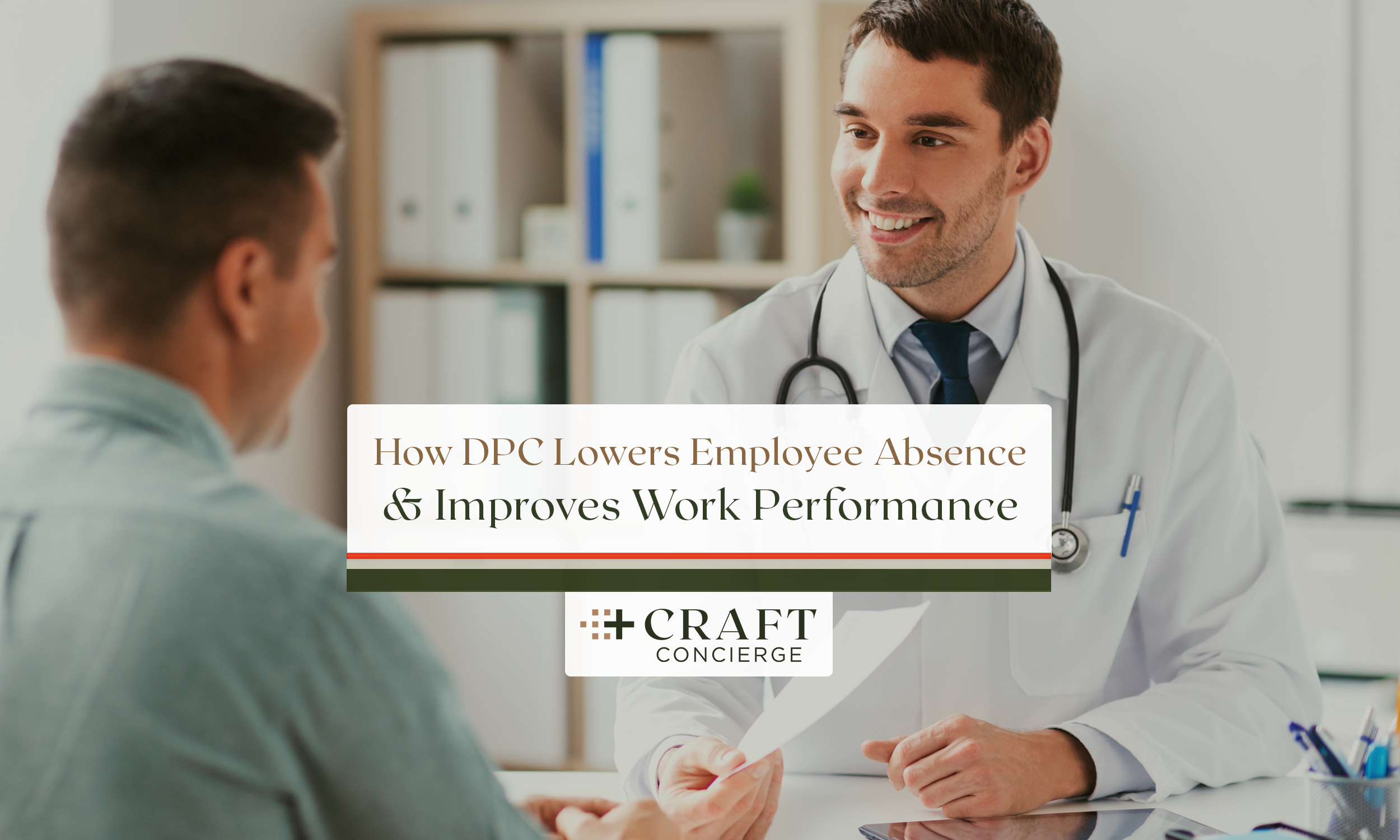If you’re an employer watching healthcare costs climb while employee productivity struggles, you’re not alone. The traditional healthcare system creates barriers that keep your team from getting the care they need when they need it—and it’s costing you in ways that go far beyond insurance premiums.
Direct Primary Care (DPC) offers a fundamentally different approach. Instead of navigating insurance bureaucracy, waiting weeks for appointments, and losing productive work hours to healthcare visits, your employees get immediate access to their physician. And the results? Healthier employees, fewer absences, better performance, and a workplace culture that actually values wellbeing.
Let’s talk about how DPC transforms both employee health and your bottom line.
Understanding the real cost of poor healthcare access
Before we dive into solutions, it’s worth understanding what inadequate healthcare access is actually costing your organization. The numbers tell a sobering story.
Health-related absenteeism currently affects about 2.14% of full-time workers in the United States. That might not sound like much until you multiply it across your workforce and realize how many productive hours you’re losing every single week. But absenteeism is just the tip of the iceberg.
The hidden costs add up quickly:
- Presenteeism: Employees showing up sick or dealing with untreated health issues work at reduced capacity. Research shows that health conditions and lifestyle risk factors significantly impact workplace productivity, often costing more than direct medical expenses.
- Administrative burden: HR teams spend countless hours managing healthcare-related absences, processing claims, and dealing with insurance complications.
- Lost revenue: When key employees can’t perform at their best—or can’t work at all—projects stall, customer service suffers, and opportunities slip away.
- Healthcare spending: Per-person healthcare costs in the U.S. are projected to reach nearly $22,000 by 2032, a 41% increase from current levels.
The traditional system isn’t just expensive—it’s actively preventing your employees from staying healthy and productive.
What makes DPC different from traditional healthcare

Direct Primary Care flips the conventional insurance model on its head. Instead of paying insurance companies to process claims and create barriers to care, you pay a straightforward monthly fee that gives your employees unlimited access to primary care services.
Here’s what that looks like in practice:
Immediate access to care: No more waiting three weeks for an appointment or spending half a day in a walk-in clinic. DPC physicians typically maintain smaller patient panels—500 to 1,100 patients instead of the typical 2,000 to 2,500—which means same-day or next-day appointments are the norm, not the exception.
Extended visit times: Standard appointments last 30 minutes or more, giving physicians actual time to understand health concerns, discuss lifestyle factors, and create comprehensive care plans. No more feeling rushed or unheard.
24/7 availability: Most DPC practices offer after-hours access through phone, text, or video consultations. That evening health concern doesn’t have to wait until morning or send your employee to an expensive urgent care facility.
No copays or deductibles: For primary care services, employees pay nothing beyond the membership fee. No surprise bills, no claim forms, no fighting with insurance companies over coverage.
How DPC directly reduces employee absenteeism
The connection between healthcare access and workplace attendance isn’t complicated: when employees can address health issues quickly and conveniently, they spend less time away from work.
The data backs this up. Studies indicate that businesses using DPC models see absenteeism reduction by up to 40%. That’s not a typo—40%.
Why DPC keeps employees at work:
- Early intervention prevents escalation: That persistent cough gets addressed before it becomes pneumonia requiring a week off work. The nagging back pain receives treatment before it turns into a chronic condition requiring extended absence.
- Convenient appointment scheduling: DPC practices often offer extended hours, including early morning, evening, and weekend appointments. Employees don’t need to take entire afternoons off for a 15-minute check-up.
- Virtual consultations minimize disruption: Many health concerns can be addressed via phone or video call, allowing employees to consult their physician during a lunch break without leaving the workplace.
- Chronic condition management: DPC physicians have time to properly manage chronic conditions like diabetes, hypertension, and asthma, reducing flare-ups that lead to missed work days.
- Preventive care actually happens: When preventive visits don’t cost extra and don’t require navigating insurance approval, employees actually show up for them. Regular screenings catch issues before they become serious problems.
The productivity boost you’ll actually notice

Reducing absenteeism matters, but the productivity gains from DPC extend far beyond just having warm bodies in seats. Healthier employees perform better, think more clearly, and bring more energy to their work.
Here’s how DPC enhances workplace performance:
Faster problem resolution: Research on DPC practices shows that on average, DPC members have 59% fewer emergency room visits, spend 30% fewer days in the hospital, and require 62% fewer specialist referrals than patients in traditional practices. That’s less disruption, faster recovery, and quicker return to full productivity.
Reduced stress and anxiety: When employees know they have immediate access to their physician, healthcare worries don’t consume mental bandwidth. They’re not lying awake wondering if they should wait another week to see if that symptom goes away, or stressing about whether they can afford the copay for an urgent care visit.
Better mental health support: Many DPC physicians provide counseling for mental health concerns, stress management, and work-life balance issues. Addressing these factors proactively prevents the burnout and disengagement that tank productivity.
Prescription management: DPC physicians can prescribe medications at cost (often through wholesale pharmacy partnerships), eliminating the affordability barriers that cause employees to skip doses or avoid treatment altogether.
Personalized wellness planning: With time to actually know their patients, DPC physicians create individualized health plans that address each employee’s specific needs and goals, leading to sustainable lifestyle improvements.
The financial case that makes sense
Let’s address the bottom line directly: does investing in DPC actually save money, or is it just another expensive benefit?
Small businesses offering DPC can save up to 40% on healthcare costs. That’s because DPC addresses problems before they become expensive emergencies, reduces unnecessary testing and specialist referrals, and eliminates much of the administrative overhead associated with traditional insurance.
Your financial benefits include:
- Predictable costs: You pay a fixed monthly fee per employee, making budgeting straightforward instead of dealing with unpredictable premium increases and claim costs.
- Reduced emergency expenses: Fewer ER visits and hospitalizations mean lower overall healthcare expenditures.
- Lower administrative burden: Less time spent managing insurance claims, appeals, and coverage questions means your HR team can focus on more strategic initiatives.
- Improved retention: Offering innovative benefits like DPC positions your company as an employer that genuinely cares about employee wellbeing, reducing turnover costs.
- Enhanced productivity: McKinsey research indicates that enhanced employee health and wellbeing could generate up to $11.7 trillion in global economic value, with organizations seeing marked improvements in productivity, reduced absenteeism, and lower healthcare costs.
Many employers pair DPC with a high-deductible health plan to cover specialists, hospitalizations, and emergencies, creating a comprehensive yet cost-effective healthcare strategy.
Building a healthier workplace culture

Beyond the metrics and cost savings, DPC does something else important: it sends a message to your team that you value their health and time.
When employees have a physician who knows their name, understands their health history, and responds to their texts, they feel cared for. When they can address health concerns without financial stress or scheduling gymnastics, they feel supported. This isn’t soft stuff—it’s the foundation of workplace cultures where people actually want to show up and give their best effort.
The cultural impact of DPC includes:
- Increased trust: Employees recognize when employers invest in meaningful benefits rather than checking boxes with minimal coverage.
- Better work-life balance: Healthcare that fits into life rather than disrupting it reduces stress and improves overall wellbeing.
- Reduced healthcare anxiety: Knowing quality care is accessible and affordable removes a significant source of worry for many employees.
- Family health: Many DPC memberships extend to employee dependents, supporting the health of entire families and reducing stress about children’s or spouses’ healthcare needs.
Making the transition to DPC
If you’re considering adding DPC to your benefits package, the process is more straightforward than you might think.
Key steps to implementation:
- Research local DPC providers: Nearly 2,400 DPC practices now operate across the U.S., with availability growing rapidly. Identify options in your area and evaluate their services, patient panel sizes, and accessibility.
- Understand coverage scope: Clarify what services the DPC membership includes—most cover preventive care, chronic condition management, acute care visits, basic lab work, and some procedures.
- Plan supplementary coverage: Determine how you’ll handle services outside DPC’s scope, such as specialist visits, emergency care, hospitalizations, and advanced imaging.
- Communicate the value: Help employees understand how DPC works and why it’s better than what they’re used to. Many people initially struggle to grasp a healthcare model without copays, deductibles, and claim forms.
- Integrate with existing benefits: Work with benefits consultants or third-party administrators to seamlessly incorporate DPC into your overall healthcare strategy.
The investment that pays itself back

At the end of the day, healthier employees cost less and contribute more. That’s not wishful thinking—it’s backed by data from businesses already offering DPC.
When you give your team real access to quality primary care, they use it. They address health issues early. They manage chronic conditions effectively. They spend more time at work and less time navigating a broken healthcare system. And your organization benefits through reduced absenteeism, improved productivity, lower healthcare costs, and a workplace culture that actually supports wellbeing.
DPC isn’t just another healthcare option. It’s a strategic investment in your workforce that delivers measurable returns in employee health, workplace performance, and organizational success.
Ready to explore how DPC could work for your team? The physicians at Craft Concierge would be happy to discuss how Direct Primary Care can support both your employees’ health and your business goals. Because when your people thrive, your organization thrives too.





